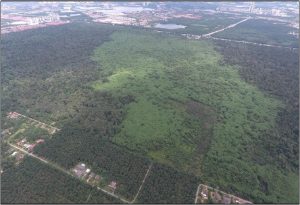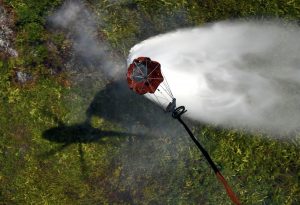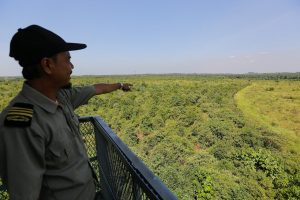By Khairul Azran Hussin and Amin Ridzuan Ishak
SHAH ALAM, Sept 11 — A total of 536.7 hectares of the Kuala Langat North Forest Reserve (KLNFR) was approved for degazettement following a series of forest fires that had “degraded” some 40 per cent of the land.
Reserved forests in Sungai Panjang in the Sabak Bernam subdistrict, in Ampang Pechah in Hulu Selangor and in Bukit Broga in Hulu Langat, totalling 581.48 hectares, were chosen as replacement land to be protected.
SelangorKini journalists Khairul Azran Hussin and Amin Ridzuan Ishak recently spoke with Selangor State Forestry Department (JKNS) director Datuk Ahmad Fadzil Abdul Majid to get to the bottom of the issue.
The interview took place two days before the state government’s decision to revoke the degazettement of the 536.7 hectares of the KLNFR on September 8. At present, the 536.7 hectares remain protected. This does not include land belonging to the Orang Asli in Kampung Busut Baru and land set aside for the East Coast Rail Link (ECRL) alignment project.
Can you tell us more about how the Orang Asli came to inhabit the land near the KLNFR?
The Orang Asli community was brought to the area when their original place of settlement was taken over to build the Kuala Lumpur International Airport (KLIA) in Sepang. They were resettled at a location near the KLNFR, not within the confines of the gazetted land, that belonged to the government.
At the time, they were promised by the then ruling government (under Barisan Nasional) a plot of land measuring 1,000 acres. They protested as the actual amount of land they received was only 870 acres, meaning they were shortchanged by about 100 acres. Through a degazettement process by the current Pakatan Harapan-led government, they were given the remaining land that was promised. And so, one of the reasons for the degazettement of the KLNFR was to provide land for the Orang Asli. The current government allocated them the 1,000 acres as promised by the previous government so that there will not be any future disputes.

To reiterate, the government has honoured the agreement to provide the Orang Asli with the land around the Kuala Langat area, even though it took 20 years to do so. We have managed to settle that problem.
Regarding the KLNFR, there are some forest areas that have been cleared since the Orang Asli moved there.
Some of these areas were already reserved for them. However, there have been instances where they cleared land that did not belong to them for farming. We will now wait and see if the relevant authorities will provide them with a permit to clear the land. This matter is still ongoing and a decision hasn’t been made.
The Orang Asli claim that there are indigenous burial sites in the KLNFR. Is this true?
During a visit with the state executive councillor for environment Hee Loy Sian to the area, we were shown one gravesite, that was all. It is a possibility that the relocated settlers from Sepang had buried one of their relatives there.
Originally, the KLNFR was categorised as a production forest. It was managed as an active logging site. When trees had reached their desired maturity they were felled for timber. Some were left to be felled at another time. We had no idea that there would be Orang Asli coming to resettle there. If the Orang Asli had been there at the beginning, surely, there would have been protests against the logging activities there.
Is it true that with the degazettement, the Orang Asli’s natural source for food will be threatened? What are the different species of animals that exist in the KLNFR?
From the aspect of reliance on the forest habitat for food, the Orang Asli have wildlife to hunt. There are numerous small mammals living in the forest, like civet cats and squirrels. There are no big mammals like elephants, seladang, tigers or rhinoceroses. There might be tapirs but not from my experience.
I am not certain about the Orang Asli’s reliance on small mammals as a food source. In general, I have not seen the Orang Asli using that area of land for food. Why is that so? Simply because it is land used for logging activities. Had it been true that they rely on the land for survival, wouldn’t they have from the beginning protested about the logging?
Land at the KLNFR has been classified as high-risk due to frequent fires. Can you tell us what the forestry department and other relevant agencies have been doing to combat the problem?
Since the year 2000, the land in that area catches fire easily. If you take a drive on the highway that passes it, you can often see smoke. The fires destroy a lot of the trees there. When new vegetation grows, it too often gets destroyed by fire.
In general, the whole KLNFR has been classified as a peat swamp. It is separated from the larger forest complex. It is surrounded at all sides by development, completely closed in.

This, coupled with the problem of illegal encroachment to plant cash crops and oil palm trees, has greatly put a strain on the forest. There have been efforts to rehabilitate the forest but we face setbacks from encroachment and fires. This year we plant, next year it goes up in flames. The cost to rehabilitate the damaged land, including maintenance and soil treatment, exceeds RM30,000 a hectare. To minimise fire damage, we build ditches and tube wells as sources of water to douse the flames.
We also receive help from the Department of Environment who deploys People’s Volunteer Corps (Rela) members to monitor the area and drive out any encroachers. In Malaysia, many such fires are caused by humans. Sometimes individuals who come to fish make a bonfire or light a cigarette, and a fire is started that way. These are the obstacles we face. High maintenance costs and the same challenges year in, year out.
It is understood that it takes a long time to degazette a piece of forest land. Many formal procedures need to take place, including a public inquiry. Can you identify the steps for us?
In the case of the KLNFR, the proposal to degazette was made as early as 2014. It was a long wait for the land owners. In 2019, the Selangor State Executive Council approved the land for development. It was at that juncture that we came into the picture. The Selangor government had imposed many conditions for the degazettement process, including the need to get proper feedback from the public. In 2020, a public inquiry took place. Expert opinions, including those from overseas, were given and taken. After that, we advertised for three more sessions of public inquiries. A committee for the hearings was set up, headed by Hee as the state exco for the environment.
It was the committee’s duty to make the decision on whether to degazette or not. It was never the forestry department’s prerogative, as believed by many. Our duty has always been to preserve the forest. The state’s law dictates that there must always be at least 30 per cent of forest land that is protected. This hasn’t changed. We currently have 31.6 per cent of Selangor’s land under preservation.
Can you tell us how many objections were received during these public inquiries and the processes that followed?
It was natural that when we had our first public inquiry, almost everyone who attended objected to the degazettement. Their objections were supported by a few individuals and also NGOs (non-governmental organisations). The conclusions of the inquiry were submitted in the form of a report to its committee. Our job scope was that only. It is the committee that consists of both state-and-Federal-appointed officers that make the final decision.
I am not sure about the details of the discussion carried out by the committee members as I wasn’t present at the meeting. There was, however, representation from the forestry department at that meeting. Everyone present put forward their opinion and in the end, it was agreed that there weren’t enough compelling reasons to preserve that area of forest. The degazettement plan went through.
This is why we say the process is long and complicated. The decision didn’t come easily. It took a long seven years. The state authorities finally went ahead, factoring in its overall plans to develop Selangor, and searched for replacement land.
What does the forestry department make of the three areas of land that have been chosen as a replacement?
It is interesting to note that the areas of land identified as replacements for the degazetted forest are of better quality. First, they are better in terms of location. Ampang Pechah in Hulu Selangor and Bukit Broga in Semenyih are well known to hikers and Sungai Panjang in Sabak Bernam is also a peat swamp.
Why do I say they are better in quality? The forest reserves in Sungai Panjang and Ampang Pechah are extensions of the existing forest complex. They are not separate entities. Therefore we can extend our surveillance to cover the whole area. Bukit Broga, however, is on its own but it is easier to manage as it is a hill.
In actual fact, for a long time now we have requested for Bukit Broga to be protected. But the process to change its status from government land to gazetted land is difficult as many districts need land for development. And because the land is still pristine, unused, we feel it is fortunate to get replacement land of such quality.
Can you tell us a bit more about the other two areas?
The replacement land in Sungai Panjang and Ampang Pechah, as I said earlier, are extensions of the original forest reserve. If we view it from the context of Selangor as a state, their importance isn’t so significant. However, they are actually part of the Titiwangsa Mountain Range that stretches from the north of the country all the way south to Johor.
This means that Selangor contributes to something much greater. The forests border Pahang’s forests, and to the north, they stretch all the way to Perak. Down south, they meet with Johor’s protected forests in Panti.
This whole range starts at Kedah’s forest reserve in Bintang Hijau.
This whole complex forms the Central Forest Spine which is home to larger mammals like elephants, tigers, bears and deer. These animals need wide spaces to roam, to avoid conflict with humans.
The land belonging to the KLNFR cannot be extended because it is hemmed in by development. And it is extremely hard to rehabilitate due to the previously discussed issues of encroachment and fires. I know that many people are worried about preserving endemic species of plants. In this age of science and technology, these species can be relocated and replanted.
Just last year, we spent RM1 million on fighting our forest fires. This year, RM500,000 was spent on water pumps and other equipment. Putting out fires actually cost a lot more than the replanting of trees.
It is the act of humans that causes the fires. Very rarely do the fires start from lightning or other natural causes because our forests are not dry enough to light a spark naturally.
Does the KLNFR have the characteristics of a good forest reserve?
In general, all forests have that potential. They protect us from flooding, give us oxygen and absorb carbon dioxide from the environment. Any 0.5 hectares of tree-covered land can be categorised as a forest.
Our forest complex has a diverse amount of species that have yet to be discovered. In the past, the benefits of forests were confined to logging. These days we know their true potential.

Our job is to educate. We will also try to look into claims that the KLNFR has species that are unique only to that place. We would like to request that people who make such claims show us how conservation of those species can be carried out. If it is indeed true that there are palm civets in the area, we will get the help of the Department of Wildlife and Natural Parks to repopulate the species in a safer environment.
The same goes for other endemic species. For example, the meranti paya tree that is said to only exist there can be found elsewhere too, like in the Raja Musa Forest and in Sungai Panjang.
What can you summarise about the whole issue?
Usually, we don’t support the degazettement of protected forest land. But in this case, many conditions were set. Once approved, replacement areas of the same quality or better must be identified. When discussions are made at the state level, and reasonable facts are put across, we accept them. On the condition that there must be replacements.
The area primed for degazettement is located very near to human development. From your experience, what harm can development bring to a forest’s ecology?
When we open up our safety borders, surely the land will be exposed to encroachers. For example, a person takes an acre of land to grow bananas. When 20 others do the same, 20 acres of land will be cleared. In time, it will only expand.
Also, there will be many enforcement issues pertaining to encroachment for leisure activities. For example, many incidents of illegal hiking have been reported in Bukit Lagong in Selayang. Honestly, we want to take action against each and every one of them but we are unable due to the sheer size of the place.
Does this mean that NGOs and nature activists have to accept the fact that the KLNFR will no longer be a safe haven for many species of flora and fauna?
They have to accept the fact. We can’t be fighting fires year in and out. Just this year alone some RM2 million has been spent. The Fire and Rescue Department, for example, had to resort to deploying amphibious fire-fighting vehicles and 100 of their personnel.
I understand that the NGOs are protecting the rights of the Orang Asli. But don’t we also want advancements for them? Our state’s plans for development are inclusive. We do not want to erase their culture. We can give them better lands, better housing. We can’t just let them depend day by day on what they can forage in the forest. There are not many animals left there to hunt anyway.





